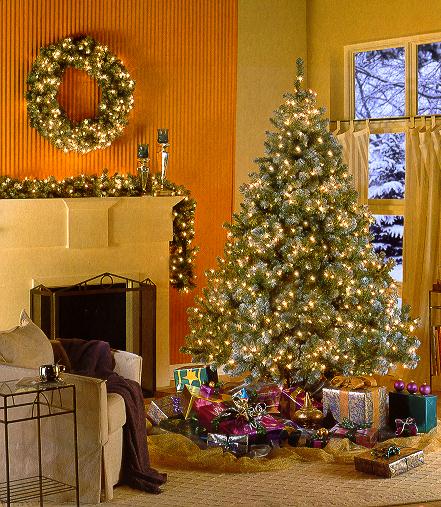
WHERE DO CHRISTMAS TREES COME FROM?
When you walk down the aisles of your favorite
Christmas tree lot
or choose and cut farm,
do you ever wonder how all those trees got there?
At one time, all Christmas trees were cut straight
out of the forest.
As you can imagine,
these wild trees looked nothing like today's
professionally
grown and sheared trees.
Today, of the over 37 million trees sold every
year,
over 95 percent are shipped or sold
directly from U.S. Christmas tree farms.
Typically, the growing process begins in nurseries
where seed is planted and grown to
two-year-old seedlings.
The seedlings are then transplanted to Christmas
tree farms.
Do you think that's it? Actually the work has
just started.
Christmas tree growing is a year
round job that takes a great deal of patience,
hard-work and experience. It takes an
average of seven years for a tree to reach its
sale height.
During those seven years the
Christmas tree must continue to be shaped and
sheared to produce the conical shape that
consumers desire.
During its growing period Christmas trees also
face threats from the weather, insects,
disease, hail or fire; overgrowth of vines and
weeds; or even theft.
Once a tree is ready for harvest, it is tagged,
bundled and loaded onto a truck for the
journey to a retail lot,
or selected right at a choose & cut farm
by families looking for a
fresh, natural addition to their holiday tradition.
REAL CHRISTMAS TREES
A RECYCLABLE RESOURCE
"Buying a real Christmas tree is definitely an
environmentally
sound choice," says Bob
Guthridge, president of the California Christmas
Tree Growers
association. "What could
be simpler or more natural?"
Although artificial tree owners will insist that
theirs is a better choice
because their tree is being used every year,
the National Christmas Tree Association says
on average, the life
of an artificial tree is just six years.
Then the plastic is tossed in a landfill where
it will lie
in a composed state forever.
"Fake trees are made of plastic and aluminum,"
says Guthridge.
"They will never break
down or decompose when they're disposed of."
Real trees on the other hand, can be
recycled and reused for other purposes.
Guthridge suggests the following post-holiday
recycling ideas for your real tree:
· Christmas trees are biodegradable -
the trunk and branches can be used as mulch for
gardens, parks or in animal stalls.
The mulch provides a protective barrier for the
roots of
other plants and vegetation while preventing
weeds from growing.
The mulch then
decomposes, providing the nutrients plants need
to thrive.
· Mulching programs are a fast-growing
trend
in communities throughout the nation. Check
with local department of public works for information.
· Some communities use Christmas trees
to make effective
sand and soil erosion barriers,
especially at beaches and on river beds.
Sunk into private fish ponds trees make excellent
refuge and feeding areas for fish.
· Before recycling, Christmas trees can
be used to make bird feeders,
adding color and
excitement to the winter garden.
Utilize orange slices, suet, and seed to attract
the birds.
They will come for the food and stay for the
shelter in the branches.
SELECTING AND CARING FOR YOUR REAL CHRISTMAS TREE
"Choosing a real Christmas tree can be fun for
the whole family,"
says Bob Guthridge,
president of the California Christmas Tree Growers
association.
He suggests a few simple
steps to follow when selecting a tree.
First, do a freshness test.
Gently grasp a branch between your thumb and
forefinger and
pull it toward you.
Very few needles should come off in your hand.
Second, take a look at the ground around the
tree.
You shouldn't see an excessive amount of green
needles on the
ground. Some interior loss of brown needles
is normal and will occur over the lifetime of
the tree.
Once you've chosen your tree, keep it in a sheltered,
unheated area such as a porch or garage to protect
it from the wind and sun until you're ready to
decorate it.
Guthridge recommends that before you set up your
tree,
you make a fresh, straight cut across the base
of the trunk
- about half an inch up from the original cut,
and place the tree
in a tree stand that holds a gallon of water.
Caring for your tree is easy.
The most important thing to remember is that
real trees need
water daily," says Guthridge.
"Never let your tree stand dry out." A tree will
absorb as
much as a gallon of water in the first 24 hours
and one or more quarts a day thereafter.
Water is important because it prevents
the needles from drying and the boughs from
drooping.
In addition, keep your tree away from heat and
draft sources
like fireplaces, radiators and
televisions sets. Test your light cords and connection
before hanging them on the tree to make sure
they're in good
working order.
You don't want to use cords with cracked
insulation or broken or empty sockets.
Also be sure to unplug lights before you go to
bed or
leave the house.
Sensible precautions such as these will help preserve
the unique beauty and tradition only a
real Christmas tree can provide.